This document presents a CFD simulation and heat transfer analysis of an automobile radiator utilizing helical tubes with two different pitches (15mm and 20mm). The study finds that 15mm pitch helical tubes offer greater heat dissipation and superior temperature drop compared to 20mm tubes, particularly at lower mass flow rates. Overall, the analysis indicates that higher mass flow rates correspond to lower temperature drops and higher pressure drops in the radiator system.
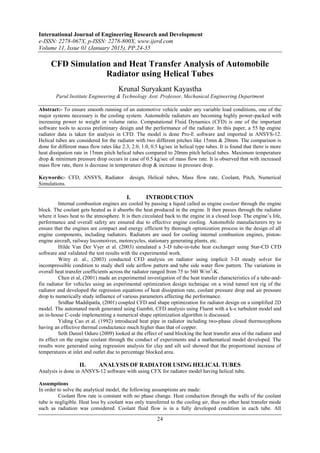


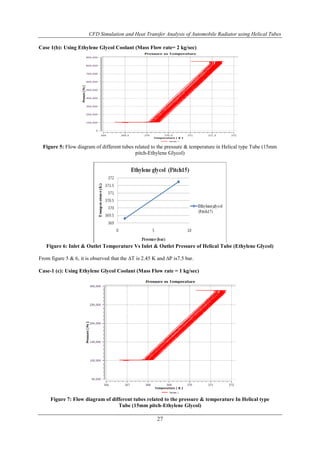
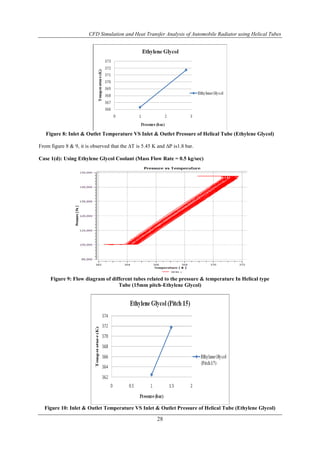


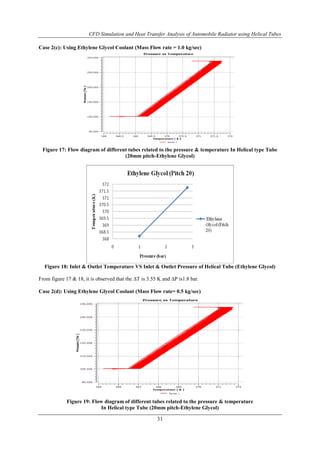

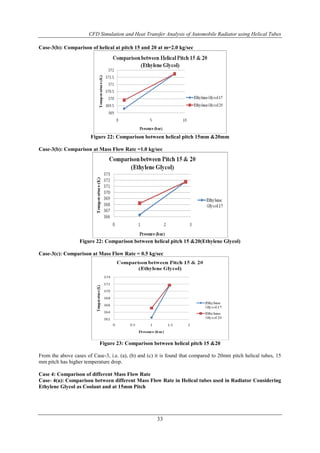
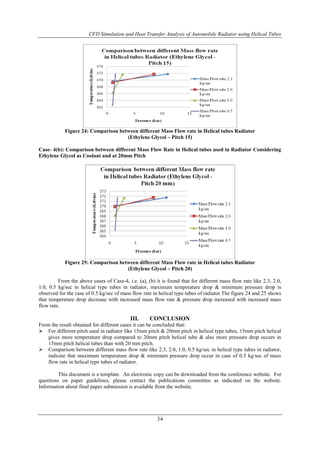
![CFD Simulation and Heat Transfer Analysis of Automobile Radiator using Helical Tubes
35
REFERENCES
[1]. A.Witry M.H. Al-Hajeri and Ali A. Bondac, “CFD analysis of fluid flow and heat transfer in patterned
roll bonded aluminium radiator”, 3rd
International conference on CFD, CSIRO, Melborne, Australia,
pp. 12-19, 2003.
[2]. Hilde Van Der Vyer, Jaco Dirker and Jousoa P Meyer, “Validation of a CFD model of a three
dimensional tube-in-tube heat exchanger”, Third International Conference on CFD in the Minerals and
Process Industry, CSIRO, Melborne, Australia. pp. 25-32, 2003.
[3]. J A Chen, D F Wang and L Z Zheng, “Experimental study of operating performance of a tube-and-fin
radiator for vehicles”, Proceedings of Institution of Mechanical Engineers, Republic of China, 215: pp.
2-8, 2001.
[4]. Changhua Lin and Jeffrey Saunders, “The Effect of Changes in Ambient and Coolant Radiator Inlet
Temperatures and Coolant Flowrate on Specific Dissipation”, SAE Technical Papers, 2000.
[5]. Sridhar Maddipatla, “Coupling of CFD and shape optimization for radiator design”, Oakland
University. Ph.D. thesis,2001
[6]. J.P.Holman, Heat transfer, Tata-McGraw-Hill Publications, 2000.
[7]. Seth Daniel Oduro, “Assessing the effect of dirt on the performance of an engine cooling system”,
Kwame Nkrumah University of Science and Technology, PG thesis, 2000.
[8]. Beard, R. A. and Smith, G. J., "A Method of Calculating the Heat Dissipation from Radiators to Cool
Vehicle Engines", SAE Technical Paper 710208, 1971.
[9]. Salvio Chacko, “Numerical Simulation for Improving Radiator Efficiency by Air Flow Optimization”
Engineering Automation Group, Tata Technologies Limited, Pune, India, Technical paper, 2003.
[10]. S.N Sridhara, S.R. Shankapal and V Umesh Babu, (2005) “CFD analysis of Fluid Flow & Heat
Transfer in a Single Tube-Fin Arrangement of an Automotive Radiator” International Conference on
Mechanical Engineering 2005,Dhaka, Bangladesh, Conference Paper, 2005.
[11]. Yiding Cao and Khokiat Kengskool, “An Automotive Radiator Employing Wickless Heat Pipes”
Florida International University, Miami,Conference Paper,1992.](https://image.slidesharecdn.com/d11012435-150408051548-conversion-gate01/85/CFD-Simulation-and-Heat-Transfer-Analysis-of-Automobile-Radiator-using-Helical-Tubes-12-320.jpg)